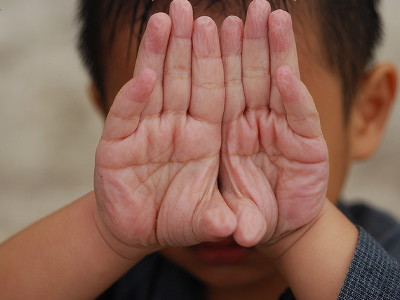It turns out that the wrinkles on your fingers that appear when you get soggy in the bath or pool tend to be the same every time

If you spend a long time in the bath or pool, your fingertips may become swollen and wrinkled. A new experiment conducted by American researchers has confirmed that the pattern of wrinkles that form is the same every time.
On the repeatability of wrinkling topography patterns in the fingers of water immersed human skin - ScienceDirect
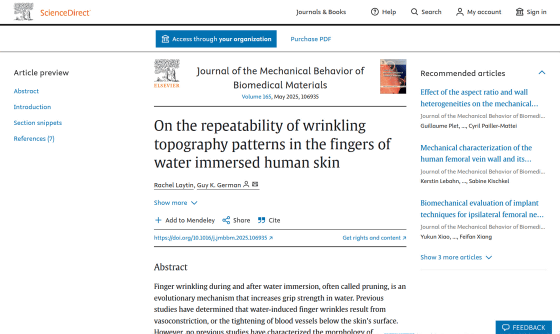
Research shows fingers wrinkle the same way with every water immersion - Binghamton News
https://www.binghamton.edu/news/story/5547/do-your-fingers-wrinkle-the-same-way-every-time-youre-in-the-water-too-long-new-research-says-yes
Fingers wrinkles in the bath the exact same way each time, study suggests | Live Science
https://www.livescience.com/health/your-fingers-prune-the-exact-same-way-each-time-study-suggests
Mystery About The Way Fingers Wrinkle in Water Might Have an Answer : ScienceAlert
https://www.sciencealert.com/mystery-about-the-way-fingers-wrinkle-in-water-might-have-an-answer
It has long been thought that the swelling of the fingers that occurs when swimming in a pool or bath is caused by water penetrating the skin and causing it to swell. However, in the 1930s, it was discovered that people with nerve damage in their fingers do not develop wrinkles even when soaking in water for long periods of time, suggesting that finger wrinkles are not caused passively by the penetration of water, but by an active response of the nerves.
Subsequent research revealed that when water enters through pores and the salt concentration of the skin decreases, the autonomic nervous system sends a signal to constrict the blood vessels in the fingertips. When the blood vessels in the fingertips constrict, the overall volume of the skin decreases, and wrinkles appear on the fingertips, just like wrinkles on dried grapes (raisins). In people with damaged nerves, the signal to constrict the blood vessels does not reach the fingertips, so wrinkles do not appear even when immersed in water.
While it's unclear exactly why we evolved wrinkles during prolonged exposure to water, some studies suggest that wrinkles on the fingertips may improve grip in wet conditions, and wrinkled toes may also help prevent slipping when walking through water.
In 2023, Guy German , an associate professor of biomedical engineering at the State University of New York at Binghamton , posted an article for children on The Conversation, a non-profit academic media outlet, about 'wrinkles on fingers that form when submerged in water.'
Why do fingers get wrinkly after a long bath or swim? A biomedical engineer explains
https://theconversation.com/why-do-fingers-get-wrinkly-after-a-long-bath-or-swim-a-biomedical-engineer-explains-204726
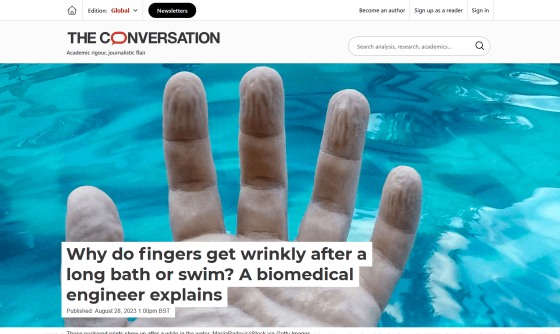
Then, a student asked, 'Do wrinkles always form in the same way?' When German saw this question, he realized that he didn't have the clues necessary to answer it, so he decided to investigate the question, 'Do wrinkles on your fingers when they are soaked in water form in the same way every time?'
German and her colleague Rachel Laitin hypothesized that because the blood vessels involved in wrinkle formation don't move around inside the fingers, wrinkles should form in the same way every time. They conducted an experiment on three subjects.
In the experiment, subjects were asked to soak their fingers in water for 30 minutes, and the wrinkles that formed on the fingers were photographed.The experiment was then repeated under the same conditions over 24 hours later, and the wrinkle patterns on each finger were compared.
As a result of the experiment, it was confirmed that the same pattern of wrinkles appeared in the same subjects in the two tests. The following images 'A' and 'B' are photos of finger wrinkles taken on different days, with the black lines indicating wrinkles that showed the same pattern in the two tests and the red lines indicating wrinkles that showed different patterns.
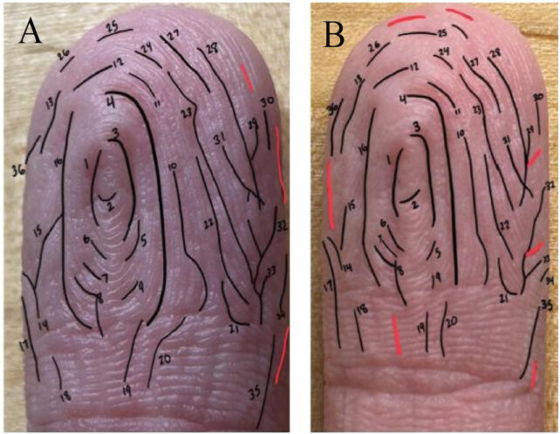
'This study shows for the first time that the topographical wrinkle patterns that develop on human hands after prolonged immersion in water are reproducible and consistent across different time points,' the team wrote. 'The results show a significant relationship between the orientation of wrinkles at both time points, indicating consistency in the shape of wrinkles over time.'
During the study, German and his team also tested a student who had nerve damage in his fingers, and found that the student's fingers did not wrinkle.
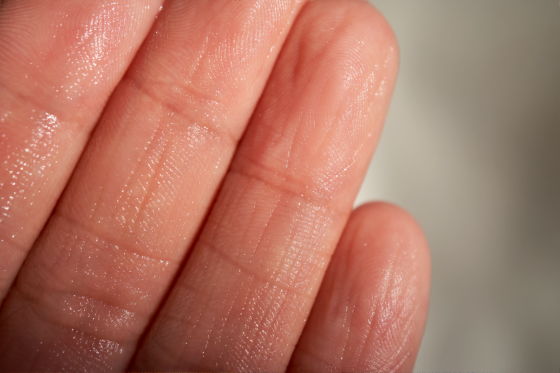
Beyond simply satisfying intellectual curiosity, the research could also have applications in forensic science, such as fingerprinting at crime scenes or identifying bodies that have been exposed to water for long periods of time -- something Jarman's father is a former police officer and says he has faced several of these challenges in his career.
'Biometrics and fingerprinting are hardwired into my brain, and I think about this kind of stuff all the time, because it's fascinating,' German said. 'I'm so grateful to everyone at The Conversation and the great questions they've asked us, because they're generating cool new science.'
Related Posts:
in Science, Free Member, Posted by log1h_ik
